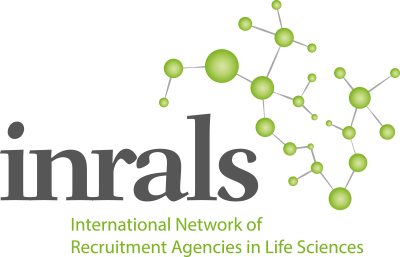
Trends in Life Science Recruiting – Expert Talk with Dilsâd Babayigit
April 23, 2021 - INRALS Member: ageneo Life Sciences ExpertsDilsâd Babayigit of our German member ageneo in conversation with Georg Kääb of Platform Life Science.*
Dilsâd Babayigit founded ageneo Life Science, a recruitment agency specializing in biotechnology, the pharmaceutical industry and medical technology, more than ten years ago. She has been active in the recruiting industry for 18 years and, with her team, offers a wide range of services for personnel and corporate development in addition to recruiting in the areas of permanent employment and project consulting (freelancer placement).
Platform Life Science (PLS): The buzzword in life sciences is currently “Artificial Intelligence”. How does that affect the search for skilled workers?
Dilsâd Babayigit: The topic is of course not entirely new, but like most digital topics it has certainly gained even more visibility due to the Corona crisis. Even if other industrial segments are already well ahead of us when it comes to AI, the topic is already playing a central role in the life sciences, too. Big data, machine learning and AI are already being used in a variety of ways – and we are still in our infancy … This has an effect on the search for qualified personnel insofar as there is a clear shift towards more personnel inquiries from the areas of IT, digitization and machine learning, AI and automation, which will certainly increase in future. In these areas, however, life science companies no longer primarily compete with their direct competitors, but also with many other industries – and first and foremost the tech and IT industries themselves.
PLS: Is it easier for larger companies in this area, or do AI experts prefer to work in the startup atmosphere?
Dilsâd Babayigit: I always struggle with generic “either or” statements. As in every department, in the AI environment it is a question of character, whether I end up at Google or Microsoft, or I see my calling in an absolutely promising start-up. The start-ups in our market segment may have one small advantage with regards to competition as many start-ups are technologically spearhead. But if a candidate wants to work in a big corporate and has to decide between Google and a pharmaceutical corporate, Google is simply the more progressive option as our industries are lagging behind. That is why so many of the large pharmaceutical companies have already decided to cooperate with small AI companies.
PLS: Is there actually a magic formula for successfully filling vacancies?
Dilsâd Babayigit: No. But there are key factors that make successful placement much more likely:
- Clarity about who and what you are actually looking for. That sounds banal, but it is one of the main reasons why placements fail.
- Clarity about the mission and objectives of the role. That sounds banal too and goes hand in hand with 1.; However, if I, as a hiring manager, cannot convey to my candidates where the role and this path is leading to, the whole thing is doomed to failure.
- A good story. The recruiting market has been a so-called “candidate market” for years. The need for new employees is higher than the amount of freely available candidates. Accordingly, the latter can choose where and for whom they want to work. Without a convincing “story” it becomes difficult to get people attracted.
- A good, quick process. If the process takes too long, it is very likely that the top candidates will drop out or have already found another opportunity. You miss the chance to get the “best”.
PLS: Small companies grow quickly, personnel structures grow more slowly – how do you get the balance in the company?
Dilsâd Babayigit: That is a particularly exciting topic! We often experience exactly how this phenomenon occurs: at some point there will come a time when the structures can no longer sustain growth and there is a painful collapse before things start to improve again. This set-back usually means two things: time delay / regression due to the creation and correction of structures and processes, departure of qualified personnel. You can avoid this if you plan in advance and direct the whole organization to this transformation process. The buzzword “change” is often overused, usually thinking of restructuring, M&A processes, strategic realignment, etc. But the fact that strong growth is also a very challenging and transformative process is often overlooked. Basically, you should also handle this – actually very positive – process as a change or transformation process, with the associated communication, etcetera.
PLS: Hiring in Corona times – everything digital, but does it work?
Dilsâd Babayigit: It works. However, it has always been known how important trust is for good performance and the (also long-term) success of organizations (Paul J. Zak’s writings are always worth a look, Zak is a very renowned neuro-economist). Virtual leadership and virtual confidence building is far more difficult to achieve than face-to-face. It takes more effort on the part of executives to create trust in virtual teams and thus create the basis for excellent performance; since there is often a lack of awareness (and also the time) for this, I see difficulties ahead of us in the medium to long term if we don’t get away from the topic of “everything digital”. As is so often the case: it’s the measure that counts.
*This article was originally published in German on the Life Sciences platform of www.goingpublic.de on April 13, 2021 and was translated and published by INRALS with permission of the author, Dr. Georg Kääb.
About the author
Dr. Georg Kääb has been editor-in-chief of the Life Sciences platform on www.goingpublic.de since February 1st. Before that, he was Manager Communications at the biotech network agency BioM for over 10 years. As a biologist, the first professional positions were as a freelance journalist at, among others, Süddeutscher Zeitung and DIE ZEIT and then for a good decade as editor-in-chief of the member magazine of the Association of German Biologists, vdbiol.
